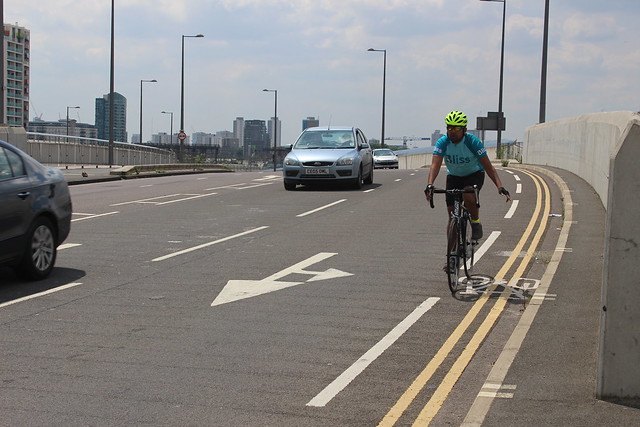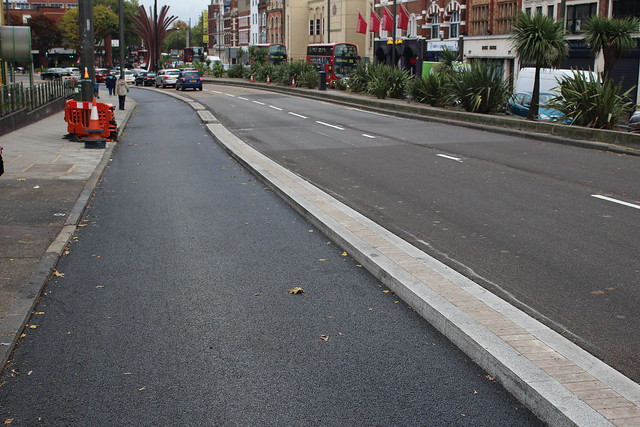Unless you've been living under a rock it won't have escaped your attention that Mayor of London Boris Johnson announced on Tuesday his intention to proceed with ambitious plans to build a "Crossrail for Bikes"; two new segregated Cycle Superhighways across central London, running from north to south and east to west. But those plans are seriously threatened due to the self-serving actions of two business groups, who could jeapordise the democratic balance of Transport for London's Board in the process.
Johnson's announcement follows one of Transport for London's largest ever consultations on a project, with a staggering 21,500 responses. So many people wanted to respond, they extended the length of the consultation to allow everyone time to air their views. But the results are conclusive; even when you discount responses automatically generated by the London Cycling Campaign's website, some 73% support the more contentious east / west route running along the Embankment.
This reflects a recent YouGov poll of Londoners of all backgrounds, the majority (64%) of which supported the cycleway plans even if it involved taking a lane away from traffic. It's also worth remembering of course that the consultation is not a referendum on the proposals; the scheme is the brain-child of our directly elected Conservative Mayor, who is mandated by the population of London to deliver his manifesto promises, of which the Cycle Superhighways were one. So far, so democratic, right?
Within minutes of the announcement on Tuesday, the Licensed Taxi Drivers Association let it be known they were furious that the Cycle Superhighways were going ahead and planned to lodge a Judicial Review. Here's what Steve McNamara, the LTDA's Secretary, had to tell Vanessa Feltz on her BBC London radio show on Tuesday morning:
"It’s an abomination!... ...The ideal route would have been to run it along the Southbank, in front of the old LWT [London Weekend Television] building all the way along there, it would have been lovely, it would have been out of the way, it would have been ideal... ...
We’re against it, lots of businesses are against
it. We are considering a Judicial Review
against the scheme in conjunction with Canary Wharf and others."
McNamara went on to give his opinions as to exactly why the Cycle Superhighways - which represent a tiny percentage of London's roads - were a BAD THING, especially if they benefit CYCLISTS:
"...they all try and tell you
this myth, that it is wealthy people driving around in cars that we need to
combat, and that it is the poor man on the cycle. And of course it’s not. What we’ve got now is this metropolitan elite
who can afford to live in the centre of the city, afford to cycle a few hundred
yards or half a mile to work, they’re the people campaigning for this. The vast majority of Londoners, working
Londoners, business Londoners – the majority of your listeners who are coming
in from the suburbs and trying to move around this city – are going to be
severely disadvantaged by this scheme...
We’re the only people in London who can actually
stand up for working Londoners, us and a few businesses who have come
together. As I say, Canary Wharf – a
massive business that employs tens of thousands of people at the Wharf - they’re concerned about their people getting
to work, we’re concerned about moving
people around the city, lots of freight companies are very, very concerned about
it, they’ve got to make deliveries.
London is a working city, it’s got to be able to work the 23 hours a day
when them cyclists are not down on the Embankment – and they’re not.... ..it’s madness.
They must see it, and we’re hoping the Courts will see it." [Click here for a full transcript of his interview]
I think it is fair to say that the LTDA has gone to war against cyclists. In November 2013 - the same month six London cyclists died on our roads in just two weeks - they gave the Evening Standard cooked up footage which claimed to show the majority of London cyclists run red lights.
Then, in March 2014 their Director wrote this frankly bizarre editorial in their member's newsletter, claiming that cycling is "bringing this city to its knees":
And now, in 2015, they're coming out all guns blazing against the Cycle Superhighway project, threatening legal action and mouthing off to anyone who will listen. But there's more to it than that, unfortunately. I'll deal with McNamara's ridiculous assertions firstly, but please do read on to the end because what happens next is even more ridiculous...
The idea that the LTDA is a paragon of working class, salt-of-the-earth virtue is preposterous: this is an organisation that gives discounts to its members for country hotel leisure breaks, golf clubs and designer glasses. (And cheap legal representation to those facing driving bans who accumulated too many points on their license) Most of their members will be earning around £60,000 a year (that's twice the national average).
Let's contrast that with the 13 people who were killed cycling in London last year: two teachers, two students, a ventilation engineer, a conference organiser, a pharmacist, a hospital porter, a bus depot worker, a solicitor, an IT worker, one person unknown and a security guard. Hardly what I'd call a "metropolitan elite".
And were those who were killed cycling "a few hundred
yards or half a mile to work"? Of course not. The majority of all cycle journeys in London originate in the fringes of zone 2 and 3 and make their way to the centre and back again. Commuting patterns like my own journey to and from work which is 10 miles, versus the city-wide average of 15 miles (That's 15 miles regardless of which mode of transport you use).
Proposals for Victoria Embankment
Taxis ferry about businessmen on expense accounts and unwitting tourists for the majority of the time, and are out of reach for most ordinary working Londoners. The last time I took a taxi from Heathrow to central London it cost nearly £100 (an awful journey during which the driver stopped his car to scream obscenities at a woman on a pedestrian crossing and deigned to share with me his abhorrently racist views for the duration of the trip). The Piccadilly Line can do the same journey - opinion free - for about a fiver.
As for sticking the Cycle Superhighway south of the river (presumably because Black Cab drivers don't go there) frankly, why should they? For a starter the whole point of the project is to get people by bicycle to centres of work quickly and safely. London's bridges are already a danger spots for cyclists, but to put it in language the LTDA would understand: around half of all the vehicles on Blackfriars Bridge during the peak hour are bicycles (that's one bike every two seconds) Are you sure putting more bikes on the bridges to get south of the river is such a good idea?
To put things in a clearer light, and to completely discredit McNamara's idea that cycle journeys are somehow unnecessary and get in the way of "working London", let's look at some actual statistics.
According to Transport for London's latest data, taxis make up 2% of all inner London road users. Bicycles make up 4%. Cycle rates in the same area have doubled over the past 10 years, whilst journeys by car have consistently declined. Across greater London there are approximately 650,000 cycle journeys every day - they can't all be Bradley Wiggins wannabes making laps of Richmond Park.
The LTDA's stance is astonishing. That they'd channel so much effort and resource in to giving such a knee-jerk and provocative reaction to a scheme that will cover a tiny percentage of London's roads (whilst their members lose massive market share to credit-card accepting mini-cab firms and book-by-app discount drivers Uber) is sad to watch. If I was an LTDA member I'd be telling them to pick their battles. As a cyclist I'd laugh if this wasn't so serious.
Uber take a pop at the LTDA's pre-historic attitude
A Judicial Review could see the Cycle Superhighway project delayed by up to 14 weeks, and it's TfL's fare-paying customers who will pick up the bill for fighting it (you know, ordinary working Londoners). But the madness doesn't stop there.
The LTDA's McNamara said they "are considering a Judicial Review
against the scheme in conjunction with Canary Wharf." You'll remember that the Canary Wharf Group were behind an anonymous briefing filled with untruths about the Cycle Superhighways which was distributed to politicians and business leaders late last year. They've also paid for a lobbyist to tour the political party conferences to try and drum up opposition to the scheme. Their strategic adviser, Howard Dawber, has appeared on television and radio claiming the project would be bad for their business and has attended numerous stake holder planning meetings.
And this is where things get ridiculous.
If a Judicial Review doesn't materialise, next Wednesday the Board of Transport for London will meet to decide whether to fund the Cycle Superhighway project or not. This is not just a case of rubber-stamping the Mayor's plans. As Cyclists In The City points out, they've picked over cycling plans in minute detail before.
But two members of the Board have a direct conflict of interest, and it would be a democratic failure were they to be allowed to participate in the funding decision...
Peter Anderson sits on the Board, and is also the Finance Director for.. ..Canary Wharf Group.
Bob Oddy sits on the Board, and is also the Deputy General Secretary of... ..the LTDA!
The LTDA's Bob Oddy, above, and Canary Wharf Group's Peter Anderson, below.
In the long term I would ask - considering there's more of us on the roads every day than there are of them - why taxi drivers are represented on TfL's Board when cyclists are not. In the short term I'd ask this: what will the Mayor do to ensure that those whose employers have been actively lobbying against this scheme are totally excluded from the process which will decide its future?
London's cycling community has fought long and hard and waited for many years for this: just ONE safe segregated cycle route across our city. This project cannot be scuppered by members of the Board who no longer have a right to be involved in it. If Anderson and Oddy think they can turn up at the Board after all their companies have done they've got another thing coming.
Transport for London's Board meeting takes place at 10AM on Wednesday 4th Feb at City Hall, committee room 4. It is open to the public and the Board papers are available online to review.
Share
































